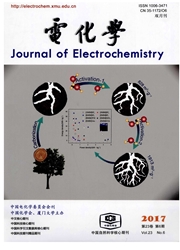

 中文摘要:
中文摘要:
在含PdCl2、NiSO4和乙二胺的弱碱性镀液中,于Au电极上用恒电位电沉积Pd—Ni合金薄膜,后经酸性溶液中循环伏安法处理,得到去合金化的Pd—Ni电极.扫描电镜以及电化学测试表明,去合金化处理使Pd—Ni镀膜表面微观粗糙度增加,比表面积增大;ICP-AES和XPS分析证实合金表层Ni的优先溶出造成Pd的富集.去合金化处理的Pd.Ni电极电催化氧化甲酸的活性明显优于未处理的Pd—Ni电极和多晶Pd电极.
 英文摘要:
英文摘要:
A Pd-Ni alloy film was electrodeposited on Au disc electrode at a constant potential from a weakly basic bath containing PdCl2, NiSO4 and ethylenediamine. The as-deposited film was then subjected to potential cycling in a perchloric acid solution for surface dealloying treatment. The dealloyed Pd-Ni film electrode was examined for the electrocatalytic oxidation of formic acid, and compared with the as-deposited one as well as a Pd film electrode. The FE-SEM and electrochemical measurements on the Pd-Ni films revealed that the dealloying treat- ment caused a surface roughening and an increase in specific surface reaction area. The ICP-AES and XPS analyses demonstrated that the preferential dissolution of Ni in the dealloying treatment led to a Pd-rich outer layer in the resultant Pd-Ni film. The electrocatalysis measurements indicated that the dealloyed Pd-Ni electrode is superior to the as-deposited Pd-Ni as well as the Pd electrode in terms of the electro-oxidation of formic acid.
 同期刊论文项目
同期刊论文项目
 同项目期刊论文
同项目期刊论文
 Infrared Spectroelectrochemical Study of Dissociation and Oxidation of Methanol at Palladium Electro
Infrared Spectroelectrochemical Study of Dissociation and Oxidation of Methanol at Palladium Electro The potential of zero total charge of Pt nanoparticles and polycrystalline electrodes with different
The potential of zero total charge of Pt nanoparticles and polycrystalline electrodes with different Crystal Habit-Tuned Nanoplate Material of Li[Li(1/3-2x/3)Ni(x)Mn(2/3-x/3)]O(2) for High-Rate Perform
Crystal Habit-Tuned Nanoplate Material of Li[Li(1/3-2x/3)Ni(x)Mn(2/3-x/3)]O(2) for High-Rate Perform Molecular dynamics investigation of structural evolution of fcc Fe nanoparticles under heating proce
Molecular dynamics investigation of structural evolution of fcc Fe nanoparticles under heating proce High-Index Faceted Platinum Nanocrystals Supported on Carbon Black as Highly Efficient Catalysts for
High-Index Faceted Platinum Nanocrystals Supported on Carbon Black as Highly Efficient Catalysts for Electrodeposition of Copper in a Citrate Bath and Its Application to a Micro-Electro-Mechanical Syst
Electrodeposition of Copper in a Citrate Bath and Its Application to a Micro-Electro-Mechanical Syst Specific reactivity of step sites towards CO adsorption and oxidation on platinum single crystals vi
Specific reactivity of step sites towards CO adsorption and oxidation on platinum single crystals vi Exploring Electrosorption at Iron Electrode with in Situ Surface-Enhanced Infrared Absorption Spectr
Exploring Electrosorption at Iron Electrode with in Situ Surface-Enhanced Infrared Absorption Spectr Electrochemically Induced Free-Radical Polymerization for the Fabrication of Amperometric Glucose Bi
Electrochemically Induced Free-Radical Polymerization for the Fabrication of Amperometric Glucose Bi Effects of nickel ion contents on electrodeposition, composition, structure and properties of pallad
Effects of nickel ion contents on electrodeposition, composition, structure and properties of pallad Electrochemically Induced Free Radical Polymerization of Methacrylic Acid and Fabrication of Amperom
Electrochemically Induced Free Radical Polymerization of Methacrylic Acid and Fabrication of Amperom XPS, time-of-flight-SIMS and polarization modulation IRRAS study of Cr2O3 thin film materials as ano
XPS, time-of-flight-SIMS and polarization modulation IRRAS study of Cr2O3 thin film materials as ano Structure and electrochemical performance of nanostructured Sn-Co alloy/carbon nanotube composites a
Structure and electrochemical performance of nanostructured Sn-Co alloy/carbon nanotube composites a QCM and EC-SPR Studies of Cytochrome c Self-assembled on Au Electrode and the Enhancement of SPR Sig
QCM and EC-SPR Studies of Cytochrome c Self-assembled on Au Electrode and the Enhancement of SPR Sig Tetrahexahedral Pt nanocrystal catalysts decorated with Ru adatoms and their enhanced activity in me
Tetrahexahedral Pt nanocrystal catalysts decorated with Ru adatoms and their enhanced activity in me Facile synthesis of a interleaved expanded graphite-embedded sulphur nanocomposite as cathode of Li-
Facile synthesis of a interleaved expanded graphite-embedded sulphur nanocomposite as cathode of Li- In situ FTIR spectroscopic studies of ethylene glycol electrooxidation on Pd electrode in alkaline s
In situ FTIR spectroscopic studies of ethylene glycol electrooxidation on Pd electrode in alkaline s Effects of iron ion contents on composition, morphology, structure and properties of chromium coatin
Effects of iron ion contents on composition, morphology, structure and properties of chromium coatin Interfacial Water at a CO-Predosed Platinum Electrode: A Surface Enhanced Infrared Study with Strong
Interfacial Water at a CO-Predosed Platinum Electrode: A Surface Enhanced Infrared Study with Strong Carbon-Supported Pd-Pt Nanoalloy with Low Pt Content and Superior Catalysis for Formic Acid Electro-
Carbon-Supported Pd-Pt Nanoalloy with Low Pt Content and Superior Catalysis for Formic Acid Electro- Combined Surface-Enhanced Infrared Spectroscopy and First-Principles Study on Electro-Oxidation of F
Combined Surface-Enhanced Infrared Spectroscopy and First-Principles Study on Electro-Oxidation of F Surface-enhanced IR spectroscopy investigation on the electro-oxidation of CO adlayer at a polycryst
Surface-enhanced IR spectroscopy investigation on the electro-oxidation of CO adlayer at a polycryst Ultralow-Platinum-Loading High-Performance Nanoporous Electrocatalysts with Nanoengineered Surface S
Ultralow-Platinum-Loading High-Performance Nanoporous Electrocatalysts with Nanoengineered Surface S A versatile electroless approach to controlled modification of Sb on Pt surfaces towards efficient e
A versatile electroless approach to controlled modification of Sb on Pt surfaces towards efficient e 期刊信息
期刊信息
